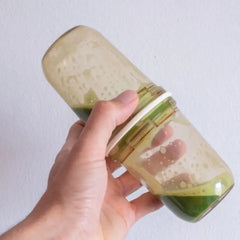How to make matcha tea without whisk is probably one of our most asked matcha questions.
Not having a matcha whisk is no reason to miss out on all the great flavors and health benefits of matcha tea.
In this article, we are going to tackle the question: can you make matcha without a bamboo whisk.
We’ll give you a few helpful methods to make your own matcha at home even if you don’t have a whisk.
Let’s get started!
How to make matcha tea without whisk complete video
Can you make matcha without a bamboo whisk? Yes!
Making matcha without whisk is possible, but it does require a little extra patience.
Although the chasen bamboo whisk has been used to prepare matcha for hundreds of years, it still is the best tool for preparing these foamy bowls of matcha tea. Instead of asking can you make matcha without a bamboo whisk, you can simply just get a free matcha whisk from us.
We are offering a free chasen matcha whisk and chashaku matcha spoon to everyone that signs up for the monthly matcha club.
With this offer, you’ll not only save big on some of the best organically grown matcha around Japan, you’ll also get all the tools you need in order to prepare it. Sign up today and cancel anytime!
Making matcha without whisk: Top 5 Substitutes
The question of how to make matcha tea without whisk can be resolved by experimenting with a few substitutes. In this next segment, we are going to examine a few tools you can use instead of a matcha whisk to make a bowl of matcha tea at home.
#1 Milk frother

This is perhaps the best substitute for a matcha whisk, but it can be just as expensive.
The milk frother is usually battery operated and it spins around to aerate different drinks.
It is usually used to make cappuccinos and other drinks with steamed milk but it can also be used for foaming matcha tea.
#2 Mason jar/bottle

If your main priority is creating foam on your matcha, the mason jar can actually be a good alternative to the matcha whisk.
Just mix up your matcha powder with water, put the lid on and then give it a good shake.
The matcha will begin to foam up almost immediately and you can then pour it out into a glass, or drink it directly out of the jar.
The only downside with this method is that it tends to produce a lot of clumps which can make the matcha really unenjoyable.
This means that it is very important to sift your matcha before mixing it.
#3 Blender

When people ask how to make matcha tea without whisk, the blender is a tool that often comes to mind.
Most people think this will make the matcha foam up immediately, but it is still pretty hard to produce the right amount of foam in the matcha.
When we tried using the blender in one of our tea experiments, we also found that it didn’t do much to break up the clumps in the matcha either.
#4 Metal Whisk
The metal whisk is a common response to the question can you make matcha without a bamboo whisk.
This may seem like an easy solution, but it is a bit harder than you’d think.
The metal bristles on the whisk slice through the water without actually aerating the tea.
There also tends to be a lot less bristles on the metal whisk, so it isn’t as good of a whisking tool.
Also, when you are preparing matcha, it tends to be a part of a calming morning routine, so the last thing you want is the sound of a metal whisk scraping against a bowl.
With enough determination however, you can use a metal whisk to get foam on the top of your matcha, it is just much more difficult.
#5 Fork

Using a fork is the last resort of people making matcha without whisk. It is incredibly difficult to create foam on a matcha with a spoon, but technically it is possible.
The fork just does not have the proper size or amount of prongs to make it truly effective when it comes to matcha making.
While the fork can be used to mix up matcha in a pinch, it really will not work as a long term solution.
Does using a whisk really make a difference?
While making matcha without whisk is possible, if you really want to get serious about matcha tea, you will want to make the investment in a bamboo matcha whisk.
Once you switch to the proper matcha making utensils, you will immediately notice a difference.
Not only will the preparation of the matcha be more enjoyable, but the taste will be much smoother and creamier as well.
How to Make a Matcha Latte Without a Whisk
Making matcha without whisk is even possible if you are preparing a matcha latte. Our favorite two methods of making matcha without whisk are with the shaker jar and with the milk frother. With the shaker jar, all you need to do is mix the matcha powder with oatmilk instead of water and then shake it up. This is a method used at a lot of coffee shops.
With the milk frother, you can add in a tiny bit of water with your matcha powder and mix it into a paste. Then you can add in a little bit of oatmilk and stir it up well with the milk frother until you get a nice foam on top. Both of these methods are just about as easy as making a normal cup of matcha.
What do you need to "whisk" matcha?
To prepare a proper bowl of matcha tea, it is normally recommended to use a few specialized utensils. A few of these can be easy to substitute, with the whisk being the hardest to substitute.
Chashaku

First you will need a bamboo spoon or chashaku. This is a spoon carved out of a single piece of bamboo and it is designed to scoop matcha powder out of a container like a matcha tin or a “natsume”.
This is made easier with the spoons vertical design, which differs from the horizontal design of a table spoon for example.
The chashaku also works well as a measurement tool, with two scoops being just about the perfect amount for a bowl of matcha tea. The chashaku can be easily replaced with a regular spoon, just make sure you find some way to measure out the powder, as 1-2 grams is the goal for each bowl of matcha.
Matcha bowl or chawan

Next we have the matcha bowl or chawan. This is pretty easy to replace with a regular food bowl, but it does have a few important features that make it great for matcha preparation.
First of all, the tea bowl is made from a thick clay so it retains heat well. If the tea bowl is properly preheated before use, it can keep your bowl of matcha tea warmer for longer, and it can even keep your hands nice and warm.
The tea bowl also has a more cylindrical shape, with higher walls which make it easier to whisk the tea without spilling, and give you plenty of space on the bottom to perfect your whisking motions.
Chasen or Matcha Wisk

Finally, we have the tool you’ve all been waiting for and that is the famous chasen.
Compared to a typical metal whisk, the chasen will have more bristles and it will be much lighter.
This makes it easier to aerate the tea, and it is much quieter as well.
While a metal whisk can also be used to create the matcha foam with enough determination, it can be really loud and unpleasant to use.
How is the Matcha Whisk made?
The matcha whisk is carved out of a single piece of bamboo. After the stalk of bamboo is selected, it is carefully cut into 16 or so different segments and then those segments are divided until there are 80-100 extremely thin bristles.
Then a string is trained in between the bristles in an alternating fashion. Every odd numbered bristle is bent in, every even numbered bristle is bent out.
The the bristles are shaped and curled to take on their final form. This can take a very long time, but some chasen whisks are still made using this traditional style.
Final thoughts on how to make matcha tea without whisk
So can you make matcha without a bamboo whisk?
The answer is a bit complicated. Yes of course you can prepare matcha without the whisk, but it won’t be nearly as good as matcha whisked up the old fashioned way.
If you would like to give the traditional method a try, it would really mean a lot to us if you could browse our selection or matcha and matcha whisks, or you can simply sign up for the monthly matcha club and well send you one for free!




